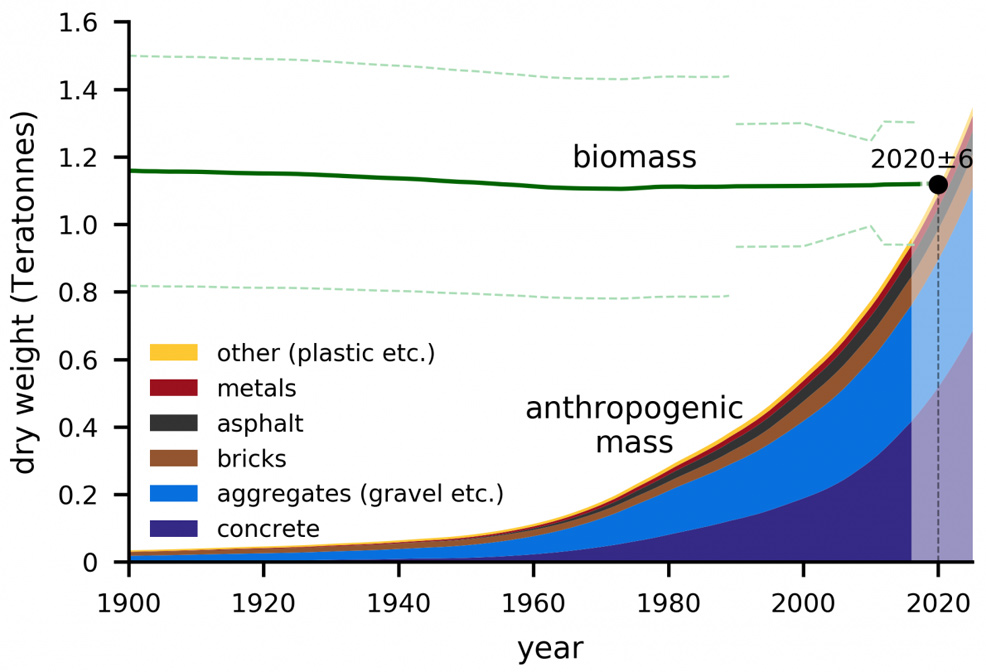
13th December 2020 Mass of human-made materials now equals the planet's biomass We are doubling the mass of the human-made, "anthropogenic" part of the world every 20 years and the curve is not flattening.
The mass of all human-produced materials – concrete, steel, asphalt, plastic and so on – has grown to equal the mass of all life on the planet, its biomass. A new study by the Weizmann Institute of Science in Rehovot, Israel, shows that we are right at this tipping point in 2020, with human activity now adding new buildings, roads, vehicles and products at a rate that is doubling every 20 years. In other words, a further doubling of this "concrete jungle" could see it reach over two teratonnes (i.e. two million million), or more than double the mass of all living things, by 2040. Professor Ron Milo, of the Institute's Plant and Environmental Sciences Department, worked with colleagues including Emily Elhacham and Liad Ben Uri to quantify the human-produced "anthropogenic mass" from 1900 until the present day. Their study, published this week in Nature, found that this figure equalled just 3% of the world's biomass at the start of the 20th century.
Not only have we humans quintupled our numbers in the last 120 years, the things we produce have far outpaced population growth. Today, on average, for each person on the globe, a quantity of anthropogenic mass greater than their body weight is produced every week. The upswing is seen markedly from the 1950s on, when building materials like concrete and aggregates became widely available. In the Great Acceleration following World War II, spacious single-family homes, roads and multi-story office buildings spang up around the US, Europe and other countries. This trend has been ongoing for over six decades, and those two materials, in particular, comprise a major component of the growth in anthropogenic mass. "The study provides a sort of 'big picture' snapshot of the planet in 2020," said Milo. "This overview can provide a crucial understanding of our major role in shaping the face of the Earth in the current age of the Anthropocene. The message to both the policy makers and the general public is that we cannot dismiss our role as a tiny one in comparison to the huge Earth. We are already a major player and I think with that comes a shared responsibility." Referring to the dynamics of the human-made materials in our world as a "socio-economic metabolism," the study invites further comparison with the way that natural materials flow through the planet's living and geologic cycles.
"By contrasting human-made mass and biomass over the last century, we bring into focus an additional dimension of the growing impact of human activity on our planet," said Elhacham. "This study demonstrates just how far our global footprint has expanded beyond our 'shoe size.' We hope that once we all have these somewhat shocking figures before our eyes, we can, as a species, behave more responsibly," said Milo. Milo and Elhacham teamed with graphic designer Itai Raveh to create a website, Anthropomass.org, to help explain these figures in clear, simple terms. "Given the empirical evidence on the accumulated mass of human artifacts, we can no longer deny our central role in the natural world," a statement on the website concludes. If the doubling rate of anthropogenic mass continues, what might this mean for the future of our world? It seems unlikely that growth of this kind could be sustained indefinitely – a plateau will surely be reached, due to limits in terms of the global population, environmental sustainability, economic stagnation and other factors. But for the sake of argument, let us assume that this trend continues unabated (perhaps humanity's population will continue to increase after all, intelligent robots and other machines could begin to join society, and our economic system will remain relatively unchanged with a focus on the business-as-usual model of endless growth). In such a scenario, today's anthropogenic mass would double by 2040, and keep doubling every 20 years after that. A rough calculation therefore provides the following projection for the distant future. In around the year 2510, the anthropogenic mass would reach approximately 2.5 x 10^22 kg. This is equal to the estimated mass of the Earth's crust. So perhaps by then, humanity or our descendants will have converted a large portion of our planet's outermost layer for their own scientific or technological uses. This may involve a hypothetical material known as computronium turning "dumb" rocks into smart, intelligent matter. Let us continue extrapolating even further ahead. The total mass of Earth is estimated at 5.9 x 10^24 kg. So by around the year 2670, our entire planet – including its crust, mantle, and core – might be fully converted for human uses. In a Singularity-type scenario of ever-expanding growth, this might be the eventual fate of our home world: its transformation into a giant machine, or hyper-intelligent being. This process might spread to every planet in our galaxy. The rather extreme scenario described here assumes that we continue on our current path, of course. We know that the trajectory being followed by humanity is unsustainable in terms of preserving a liveable planet for the long term. Our economic model will surely have to change at some point and in some way, to better account for Earth's living systems and to recognise the enormous impact we now have on the planet.
--- Follow us: Twitter | Facebook | Instagram | YouTube
Comments »
If you enjoyed this article, please consider sharing it:
|









